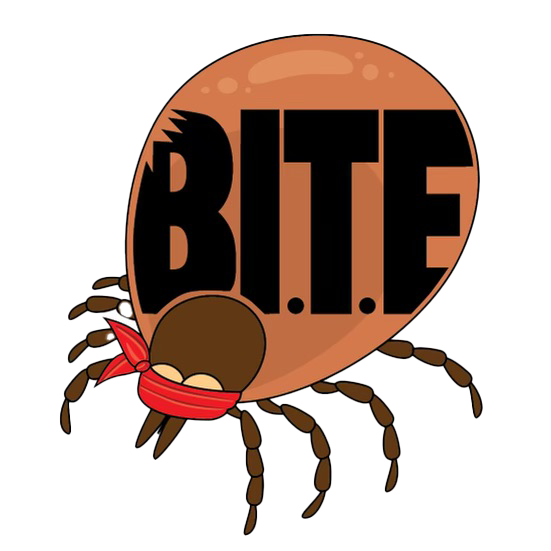BITE

A green alternative to DEET derived from naturally-occurring carbon binding compounds.
- The CDC estimates approximately 100,000 Lyme disease cases per year in Pennsylvania, the highest number of diagnosed Lyme disease cases in the country.
- Ticks find us via CO2-detecting sensors on their forelegs, which allows them to follow the CO2 released from our skin.
- Our solution prevents ticks by using compounds that bind directly with the CO2 released from human skin, effectively masking us from tick detection.
- Our product could make the use of DEET to repel ticks obsolete, without the potential negative side-effects of DEET products.
- B.I.T.E Tick Repellent would make humans invisible to the ticks - a cloak of invisibility to prevent Lyme and other diseases carried by ticks!
It is estimated that 14% of the world population has had or currently has Lyme Disease, with an estimated 300,000 of those affected being in North America. Ticks carry and cause Lyme disease transmission, seeking out their hosts via carbon dioxide (CO2) detection, notably CO2 released by the skin.
Currently, DEET is the recommendation for the prevention of tick bites by the CDC. However, the side effects of DEET can lead to irritation, discomfort, and excessive tearing. Prolonged application of DEET on the skin has been known to cause irritation, redness, rash, and swelling.
The lack of research on the ecological toxicity of DEET is due in part to the EPA’s registering of DEET as an indoor use chemical, with no ecological risk assessments performed. However, research shows that DEET is present in water samples - including urban and rural water systems, sewage-treatment plants, groundwater, and taps.
Ticks seek out their hosts via CO2 detection. Sensors on their forelegs are used to follow the carbon dioxide concentration gradient to their host. If we can find natural compounds that bind the CO2 released by the skin, they may prove to be an effective way to prevent detection. Effectively making the humans invisible to the ticks – think a cloak of invisibility to ticks!
Our compounds are natural CO2 binding agents found in humans and crustaceans. The biophysical properties of these compounds are optimal for binding CO2 in their respective species (making human and dog deterrents, for example, very different).
This proposal aims to determine if these compounds are capable of absorbing sufficient CO2 when dissolved into solvents, acting as a topical repellent for ticks (including glycerol and water, petroleum jelly, aloe vera, coconut oil, and avocado oil). This approach also enables us to test multiple variables, including humidity, temperature, and CO2 emission.
We expect that our compounds will prevent tick binding by restricting the release of detectable CO2 from the skin. If successful, we will also test different vector delivery of the compounds including suspensions, lotions, and aerosols. The goal of this project is to investigate a new green alternative to DEET and Permethrin using natural CO2 binding agents.
- Jill D. Henning, Ph.D. (PI of the project, Professor of Biology Pitt-Johnstown) leads our project with her background in infectious diseases. Currently, Dr. Henning sits on the PA State Lyme Disease board which makes her an excellent source of information on the disease, and she will lead the Public Health communication and assist in the tick migration studies.
- Manisha Nigam, Ph.D. (Co-PI, Associate Professor of Chemistry Pitt-Johnstown) is Green Chemist with extensive expertise in developing environmentally-friendly experiments for educational purposes. This makes her perfectly poised to lead the sustainability of the project, and she will lead the CO2 bind experiments.
- Luis Bonachea, Ph.D. (Co-PI, Associate Professor of Biology Pitt-Johnstown) is an invertebrate physiologist. His background in physiology provides unique insight into the molecular workings of the compounds, and he will lead the questing tick experiments.
- Matthew Tracey, Ph.D. (Co-PI, Assistant Professor of Chemistry, Pitt-Johnstown) is a medicinal chemist. This allows him to uniquely understand the application of our compounds to human skin.
Many individuals enjoy time engaging in outdoor activities. While outside they run the risk of contracting Lyme disease. In fact, globally it is estimated that 14.5% of the world has had or has Lyme disease. The annual cost of Lyme disease in the USA is $1.3 billion. DEET is currently recommended for use, but there are significant side-effects that cause many to seek a scientifically-sound, effective alternative. There are “natural” DEET alternative products being sold, but they may not be effective.
As a result of the PInCh award, we will conduct experiments to determine the binding affinity of the compounds to CO2 as well as the efficacy of this strategy in controlling the behavior of the ticks. Funding will cover lab development and data gathering (basic research and if successful translational research). Since the proposed compounds align with the "Clarification of FDA and EPA Jurisdiction Over Mosquito-Related Products" and don't impact body structure or function, this product can be marketed over the counter. This research is timely, with the push for more environmentally friendly vector repellents.
- Does the Lyme vaccine negate the need for this product? Pharmaceutical companies are in clinical trials for vaccines for Lyme disease; however, the vaccines will not prevent infection or exposure to the other diseases ticks carry. Given that ticks carry six other pathogens, and that vaccine hesitancy is on the rise, a safe effective repellent for ticks is warranted.
- Are ticks attracted to radiant heat in addition to CO2? Ticks' attraction to CO2 emissions is established. Our study design integrates temperature and CO2 levels. Unlike work using "cold" and "warm" plates without considering CO2, our experiment enhances data by incorporating physiological CO2 conditions with temperature. This more precise approach will yield crucial field-relevant insights into tick attractants.
- What will your product cost to consumers? We acknowledge that the cost of any final product for market is at present unknown.